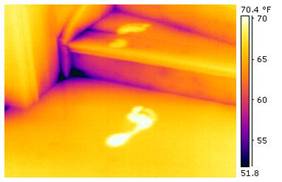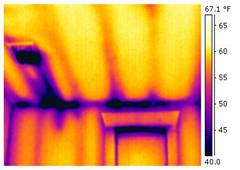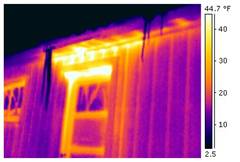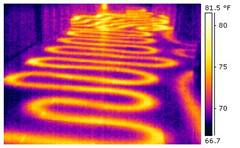WHAT IS THERMOGRAPHY?
Thermography or Thermal Imaging uses a non-invasive infrared camera to “see” and “measure” heat. All materials emit heat energy. Thermographic images can reveal hidden anomalies and identify problems in buildings and their component electrical, mechanical, plumbing, and water-proofing systems. Infrared cameras can not only see in real-time, but can also record infrared images and measure the temperatures of target objects to within 1/10 of a Fahrenheit degree. By comparing areas of hot and cold, trained technicians can expose possible hidden or unknown areas of concern.
Use of recorded thermal images can aid greatly in communications among trade, attorneys, and other professionals while serving as a clear and valuable data in legal cases.

Thermal imagery is not…
Thermal imagery is not an X-ray and can not identify every hidden issue. Thermal imagery can only display the temperature variants in scanned objects or structures.
Thermal imagery in not a moisture meter, but can aid in identifying areas that warrant further investigation.
The use of thermal imagery is not a Silver Bullet fix but can greatly aid in the detection of hidden issues that may be missed during a normal limited visual home inspection.
Use of thermal imagery does not guarantee identification of all concealed damage. It can only detect and display current thermal differences and/or anomalies.
USES FOR THERMAL IMAGERY
Moisture, heat loss & cold air leaks, plumbing issues, radiant tubing location & leaks, electrical issues, and locating structural members in exterior walls and roof of the building envelope are just a few of the uses of thermal imagery.
Thermal imaging can aid in the detection of MOISTURE detection in ceilings, walls, floors, and roofing products. Moisture equals mold. Whenever a leak occurs and moist conditions are present longer than 72 hours, mold can form. The use of a thermal infrared camera can quickly aid in identifying moisture problems in a non-invasive manner.

Thermal imaging can identify heat loss or poorly insulated areas in the building envelope. We specialize in Energy Audits and we utilize an infrared camera to help identify “leaky spots” in the building envelope where corrections and improvements can be made to improve the tightness and energy efficiency of the home, thus reducing heating & cooling cost.
Thermal imaging can help identify hidden moisture problems around plumbing supply and waste lines and plumbing fixtures. We scan around exposed water supply and waste lines and plumbing fixtures to help detect moisture leaks. Since infrared cameras are not a moisture meter, it is used to detect temperature differences and a moisture meter can then be used to verify moisture content in the building materials.
Thermal imaging can locate radiant “in-floor” tubing in floors and slabs which can aid the contractor or home owner in retrofit or remodeling applications. Thermal imaging can also be helpful in detecting leaks in radiant tubing and allow the contractor or home owner to minimize the amount of flooring removal in order to locate and repair the leak, thus saving time and money$$.

Use of an infrared camera can also aid in detecting electrical HOT spots that may be the result of overloaded circuits, loose or corroded electrical connections, or other anomalies that can result in a fire hazard.
Thermal imaging can identify structural framing members in the exterior building walls and roof to assist architects and engineers in designing for remodels and additions to homes.
Give us a call today and order your Complete Thermal Scan. See our Fees & Services on our web site for pricing on Complete Home or Building scans or hourly rates for trouble shooting problems.



